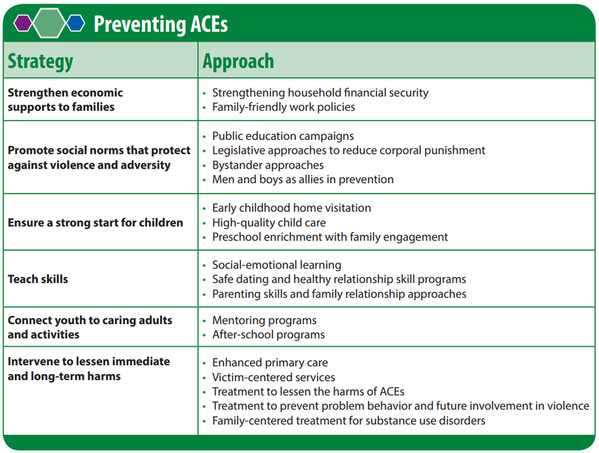The Centers for Disease Control and Prevention (CDC) has just launched a three-year, four-state, $6-million project, “Preventing Adverse Childhood Experiences: Data to Action (PACE-D2A)” with the potential to energize an already blossoming movement of statewide community-based initiatives to address ACEs.

The CDC awards of $500,000 annually for three years, announced on August 25, were given to the Department of Public Health in Georgia and Massachusetts, the Office of Early Childhood in Connecticut, and the Michigan Public Health Institute (MPHI). MPHI is a non-profit research institute established by the Michigan legislature to build the capacity of the state to quickly address urgent issues, the COVID crisis being the latest.

The early impressions of the principal investigator of the MPHI award, Mat Edick, PhD, director of Center for Strategic Health Partnerships (one of about a dozen centers at MPHI), provide one state’s perspective on the earliest stage of this multi-year project. Background information on PACE-D2A project follows this Michigan snapshot.
Michigan focuses on partnerships in a collaborative process
Self-identified “data geek” Edick says the project is “hands on” with CDC, in contrast to National Institutes of Health (NIH)-supported research, for example, where the awardee’s work proceeds independently once given the green light. He describes a collaborative process where the CDC team works closely with awardees and gives the go-ahead as each phase is undertaken. CDC will provide technical assistance to the states and opportunities for the states to share what they are learning with each other, not dissimilar to a learning collaborative, according to Edick.

Lisa Farnum, Michigan Association of Health Plans Foundation/
Michigan ACE Initiative
Edick says that “a perfect storm of partnerships” may have been a key factor in MPHI’s successful application. The Notice of Funding Opportunity (NOFO) places great emphasis on collaboration and partnerships both within state government and communities. One of MPHI’s central partners is the Michigan ACE Initiative, started about four years ago by the Michigan Association of Health Plans (MAHP) and the MAHP Foundation. The foundation’s managing director/MI ACE Initiative, Lisa Farnum, along with Rick Murdock, former director of the MAHP, were founders of the Michigan ACE Initiative. As an organization representing healthcare payors, MAHP’s founding role in the initiative gave it credibility with other organizations—payor buy-in demonstrated the potential for payment policies to support future recommendations of the initiative.
Edick says the involvement of the Michigan ACE initiative with its vast organizational support (nearly 40 organizations are supporters, including MAHP) made it an invaluable leadership partner for the CDC project. Other partners bring different expertise and depth to the project, including the state’s Department of Health & Human Services, Department of Education, Central Michigan University, and the Children’s Trust Fund.
Data collection strategies
The NOFO (attached), according to Edick, emphasized building the infrastructure and capacity of the state to collect and share data. The data is one tool to inform decisions related to policy, funding, and steps for building resilience, according to Edick. He envisions data collection that is actionable at multiple levels—not just statewide but locally including counties and neighborhoods, and not just used by policymakers but by members of communities. He suggests that a key to positive outcomes lies in community-specific strategies is to address problems identified by people experiencing them. For this to happen, he says the data must be accessible and understandable by community members, and cannot be “just a big pile of data.” The goal is to collect data that is useable and interpretable to the community, as well as policymakers.
To make the data actionable, a key strategy according to Edick is to create a data dashboard to gather multiple sources into a single repository where data is comparable and useful. Partners in this work include the epidemiology division in the Department of Health and Human Services and the Department of Education that administers the Youth and Adolescent Behavioral Survey (YRBS). The current Michigan YRBS has only one or two ACEs or ACEs-adjacent questions and there is reluctance to add more, especially while the educational system is under particular stress with COVID 19.
Other possibilities for collecting ACEs data are designing a new survey instrument and creating innovative ways to collect data such as “Text to” and “web panel” approaches. An example of the “text to” approach would be posting ACEs-related questions on a poster in a virtual classroom that could provide interesting data (and involve underrepresented individuals), approaches not necessarily meeting the standards of the state’s epidemiologists, says Edick.
Individuals, organizations, and communities interested in becoming involved and learning what is happening in Michigan are encouraged to join the Michigan community on ACEs Connection—Michigan ACEs Action.
Congressional genesis of project
Derrick Gervin, PhD, Team Lead for PACE-D2A project, said on a May 14 webinar that his division had to fast track this program, learning of congressional action in December, 2019 and issuing the NOFO in four months, an unusually short period for the development of such a project. The FY ’20 Appropriations law includes “funding to inform how adverse childhood experiences increase the risk of future substance use disorders, suicide, mental health conditions, and other chronic illnesses as authorized in section 7131 of the SUPPORT Act (P.L. 115–271).” The SUPPORT Act, “Substance Use-Disorder Prevention that Promotes Opioid Recovery and Treatment for Patients and Communities Act,'' is the bill signed by President Trump on 10/24/2018 in response to the opioid crisis.
How the project defines ACEs
The NOFO says that ACEs “are preventable traumatic events that occur in childhood (0-17 years)” and include such things as neglect and witnessing violence and also include ”aspects of children’s environment that undermine their sense of safety, stability, and bonding such as growing up in a household with substance misuse.” It notes the importance of surveillance to understand the scope of the problem, where ACEs are most likely to occur, and who is at greatest risk. It identifies a deficit in surveillance for youth and adolescents, noting that the Behavioral Risk Factor Surveillance System (BRFSS) assesses ACEs retrospectively among adults.
Scope of the project
The funding announcement outlined three areas of work to be undertaken by the recipients:
—enhance or build the infrastructure for the state-representative collection, analysis, and application of ACE-related surveillance data that can be used to inform and tailor ACE prevention activities;
—implement strategies based on the best available evidence to prevent ACEs; and
—conduct data to action activities to continue to assess state-wide surveillance and primary prevention needs and make needed modifications.
In addition, the announcement said: “Recipients will focus on the implementation of at least two designated strategies derived from CDC’s Division of Violence Prevention’s (DVP) resource, Preventing Adverse Childhood Experiences (ACEs): Leveraging the Best Available Evidence. In these endeavors, recipients will be expected to leverage multi-sector partnerships and resources in order to improve ACEs surveillance infrastructures and to coordinate and implement ACEs prevention strategies. As a result, recipients will better understand the burden of ACEs in their communities and engage in strategies that will prevent ACES from occurring, in order to help to promote safe, stable, nurturing relationships and environments where children live, learn and play.” The “Preventing ACEs” document was released in 2019 by the Division of Violence Prevention, National Center for Injury Prevention and Control.
The Preventing ACEs document outlines six major strategies from which awardees are to choose at least two. They include strengthening economic supports to families and promoting social norms that protect against violence and adversity.

In the 20+ years since the publication of the CDC-Kaiser Permanente Adverse Childhood Experiences Study, the CDC, a revered institution now embroiled in controversy, has added to the growing momentum around the acceptance and implementation of ACEs science on several fronts. It has supported the inclusion of the ACEs module in the BRFSS in nearly every state. It issued the ACEs Vital Signs report in late 2019 that provides the first U.S. estimates of how preventing Adverse Childhood Experiences (including child maltreatment) and associated trauma has the potential to reduce chronic diseases, risky health behavior, and socioeconomic challenges. The study examines ACEs in 25 states between 2015-2017. And now, with congressional authorization and funding, the CDC’s National Center for Injury Prevention and Control is implementing the PACE-D2A project. The CDC also made related resources on the Vital Signs report available.
Highlights from the other states—Connecticut, Massachusetts, and Georgia—will be reported here on ACEs Connection as interviews are completed.






Comments (0)